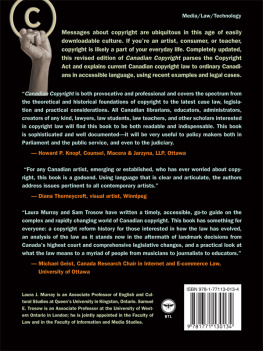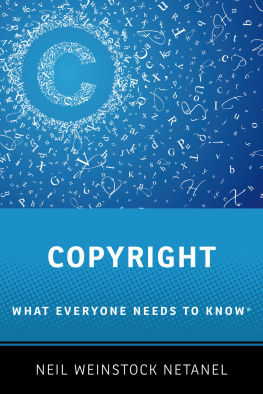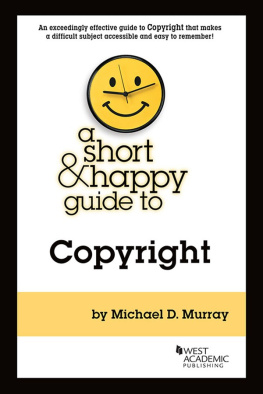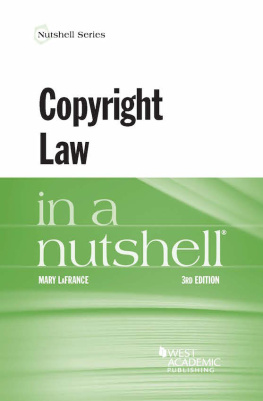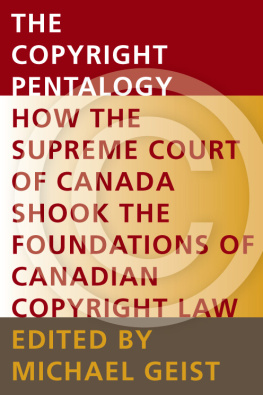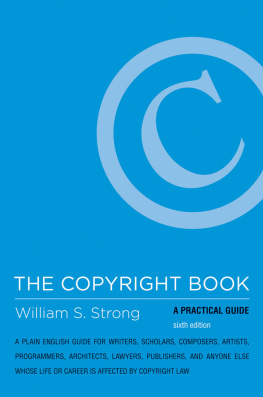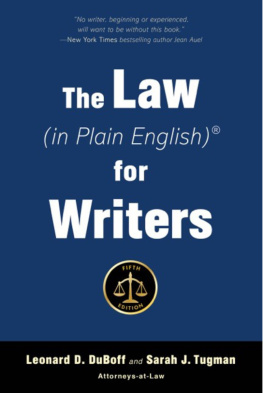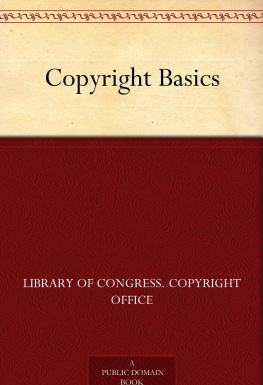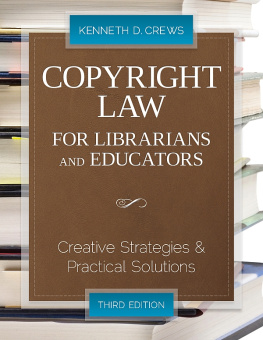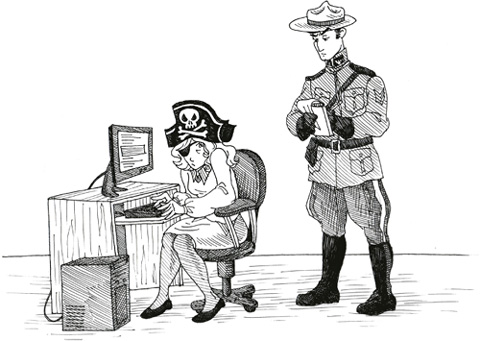Praise for
CANADIAN COPYRIGHT
Sophisticated and thorough in its approach, using up-to-date cases and examples, Canadian Copyright: A Citizens Guide presents an accessible and engaging explanation of intellectual property law. Murray and Trosow capture the complexities of the Canadian tradition, drawing on recent court decisions by Madame Justice Rosalie Abella and reaching back to the wisdom of Northrop Frye. This book is ultimately empowering, with knowledge that you can use when it comes to intellectual property.
JOHN WILLINSKY , Professor of Publishing Studies, Simon Fraser
University, and Khosla Family Professor, Stanford University
As an artist who is actively seeking to broaden my reach, I frequently adopt new ways to connect with my audience online. Canadian Copyright: A Citizens Guide helped me understand how copyright works in Canada and how I can use it to protect my work and message as an artist.
SONNY ASSU , interdisciplinary artist, Montreal
Murray and Trosows book is essential reading for anyone anywhere who wants to understand howencouraged by Canadian civil societyParliament and the courts have taken a lead role in the worldwide struggle for balanced copyright law. Canadian Copyright points out the struggles that lie ahead, in particular with regard to assuring that copyrighted content is fully available for educational use. Accurate without being hyper-technical, wonderfully readable, and with a consistent emphasis on how choices about copyright law affect real-life patterns of cultural production and consumption, this volume is truly a model of its kind.
PETER JASZI , Professor, American University Law School
In an area of public debate often marked with frustrating polemic and oversimplification, Canadian Copyright: A Citizens Guide provides a nuanced, articulate, accessible, and, perhaps most importantly, uniquely Canadian perspective. This book is essential reading for students not only of copyright, but also of Canadian culture.
KEITH SERRY , President, Clinique Juridique des Artistes
de Montral/The Montreal Artists Legal Clinic Co-founder,
Canadian Music Creators Coalition
Trosow and Murray offer an insightful account of copyrights relevance to all of uscitizens, academics, innovators, and creators of all stripes. Updated to reflect the latest word on Canadian copyright lawfrom both Parliament and the Supreme CourtCanadian Copyright: A Citizens Guide offers a much-needed account of how copyright affects all of us.
DAVID FEWER , Director of the Samuelson-Glushko Canadian
Internet Policy & Public Interest Clinic
LAURA J. MURRAY & SAMUEL E. TROSOW
BETWEEN THE LINES TORONTO
Canadian Copyright: A Citizens Guide, Second edition
2013 Laura J. Murray and Samuel E. Trosow
First published in 2013 by
Between the Lines
401 Richmond Street West
Studio 277
Toronto, Ontario M 5 V 3 A 8
Canada
1-800-718-7201
www.btlbooks.com
All rights reserved. No part of this publication may be photocopied, reproduced, stored in a retrieval system, or transmitted in any form or by any means, electronic, mechanical, recording, or otherwise, without the written permission of Between the Lines, or (for photocopying in Canada only) Access Copyright, 1 Yonge Street, Suite 1900, Toronto, Ontario, M 5 E 1 E 5.
Every reasonable effort has been made to identify copyright holders. Between the Lines would be pleased to have any errors or omissions brought to its attention.
Library and Archives Canada Cataloguing in Publication
Murray, Laura Jane, 1965
Canadian copyright [electronic resource] : a citizens guide / Laura J. Murray and Samuel E. Trosow ; illustrator, Jane Burkowski.2nd ed.
Includes bibliographical references and index.
Electronic monograph.
Issued also in print format.
ISBN 978-1-77113-014-1 ( EPUB ).
1. CopyrightCanadaPopular works. 2. CopyrightCanadaCases--Popular works. I. Trosow, Samuel E II. Title.
KE 2799.2. M 87 2013 346.7104'82 C 2012-907737-2
KF 2995. M 87 2013
Text design by Gordon Robertson
Front cover photo Dan Kosmayer / Shutterstock.com
Printed in Canada
Between the Lines gratefully acknowledges assistance for its publishing activities from the Canada Council for the Arts, the Ontario Arts Council, the Government of Ontario through the Ontario Book Publishers Tax Credit program and through the Ontario Book Initiative, and the Government of Canada through the Canada Book Fund.
Tables
Introduction
T hese days copyright has become part of just about everyones life. Thats why you are reading this book. Whether you are a parent, artist, business person, blogger, teacher, student, or music fan, questions about copyright law have popped into your head or landed in your lap. You may want to stop people from using your screenplay or photograph without your permission. You may wonder whether you should read all that legalese on a software licence or a publishing contract, and whether youd understand it if you did. You may want to know if its okay to capture an image from somebody elses website and post it on your own. You may wish you knew how to argue with a boss, a teacher, or a lawyer who says, You cant do that.
In this book, we seek to help you out with these practical questions. But we admit right off the bat that this is not a dummies guide. Well take you through some history and philosophical underpinnings on the way to the answers. Copyright law, like all law, is not like a series of switches. Its a human creation. And it is still very much still a work in progress. Over the years, and in different countries, it has become diversified as it is adapted to many new situations and technologies.
Most people see copyright law, along with law in general, as static: some things are illegal, some things are legal, and the judge will tell us which is which. If it isnt static, many people think it ought to be: that with the right tools we can immobilize copyright law and make it more certain. But in fact all law is always developing in a complex and fitful waythrough changing legislation, through legal precedents from case law, and through the practice and beliefs of ordinary citizens. Law is not a thing, but a process based on a set of social relationships. For many people this aliveness of the law produces confusion, but in copyright, as in other areas of law, we think it also produces opportunities. If ordinary people educate themselves about the history and various incarnations of copyright around the world, they can glimpse principles, costs, and possibilities often masked by the misleading self-evidence of the here and now. Widespread knowledge of the law can enable people to make more effective use of itin our terms, to practise fair copyright.
A sense of popular empowerment and responsibility is just as important now as it was in 2007 when the first edition of this book came out. At that time, Canada was in the midst of a major debate over what direction legislative reform should take. In fact, we were worried that our book would become out of date within months of its publication! But the legislative reform did not happen until 2012, in the form of Bill C-11. That was a big year for copyright in Canada: only shortly after C-11 passed, and even before it was enacted into law, the Supreme Court delivered five copyright cases that have an important bearing on users rights and technological neutrality issues. At around the same time, a large number of universities decided not to renew their licences with the major educational copyright collective, Access Copyright. So, even though Access Copyright has continued with its strategy of lawsuits and tariff applications, the legal landscape is very different now than it was in 2007. It is more certain in some ways, but the challenge is for Canadians to take up and inhabit the new environment.

